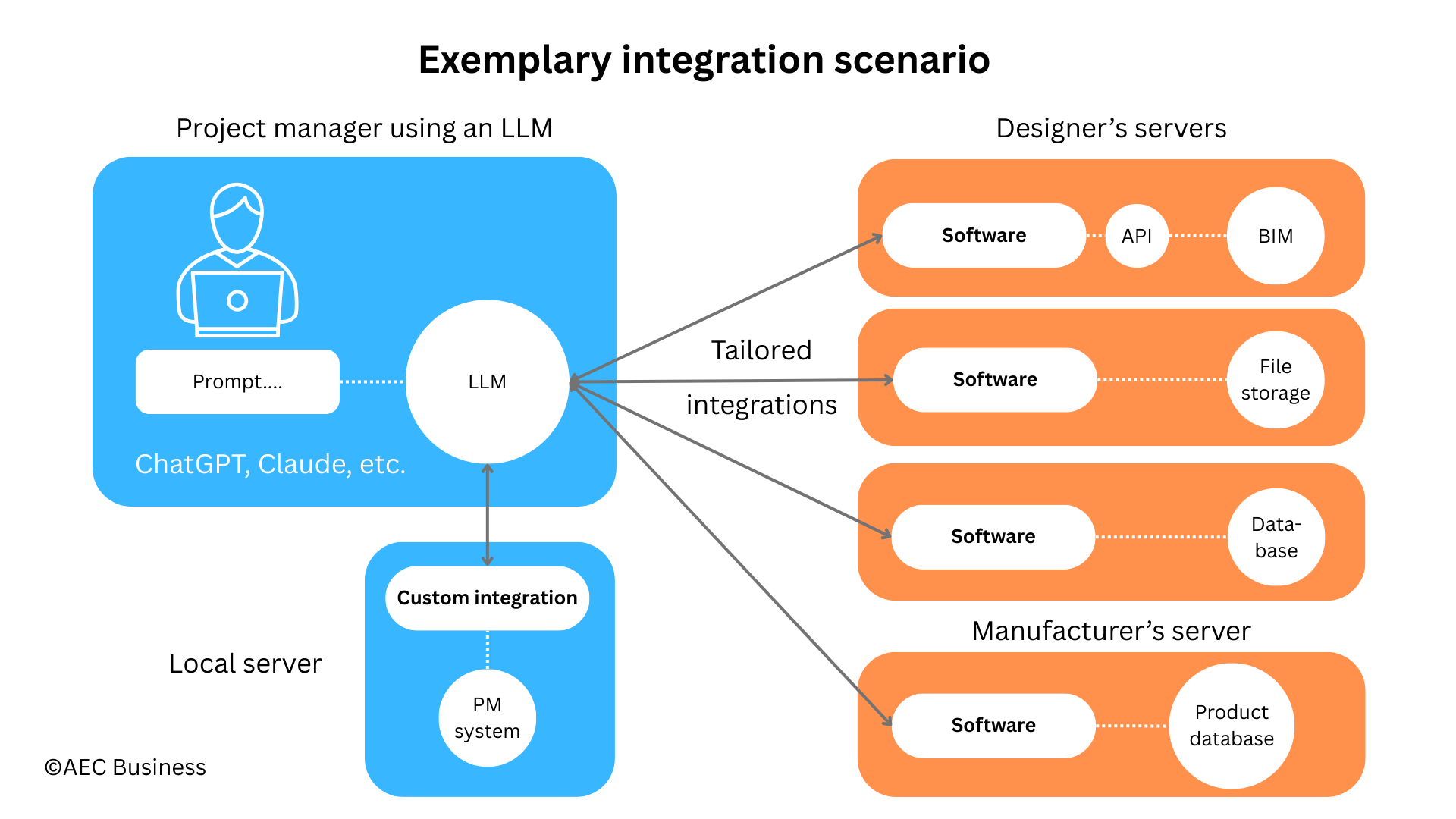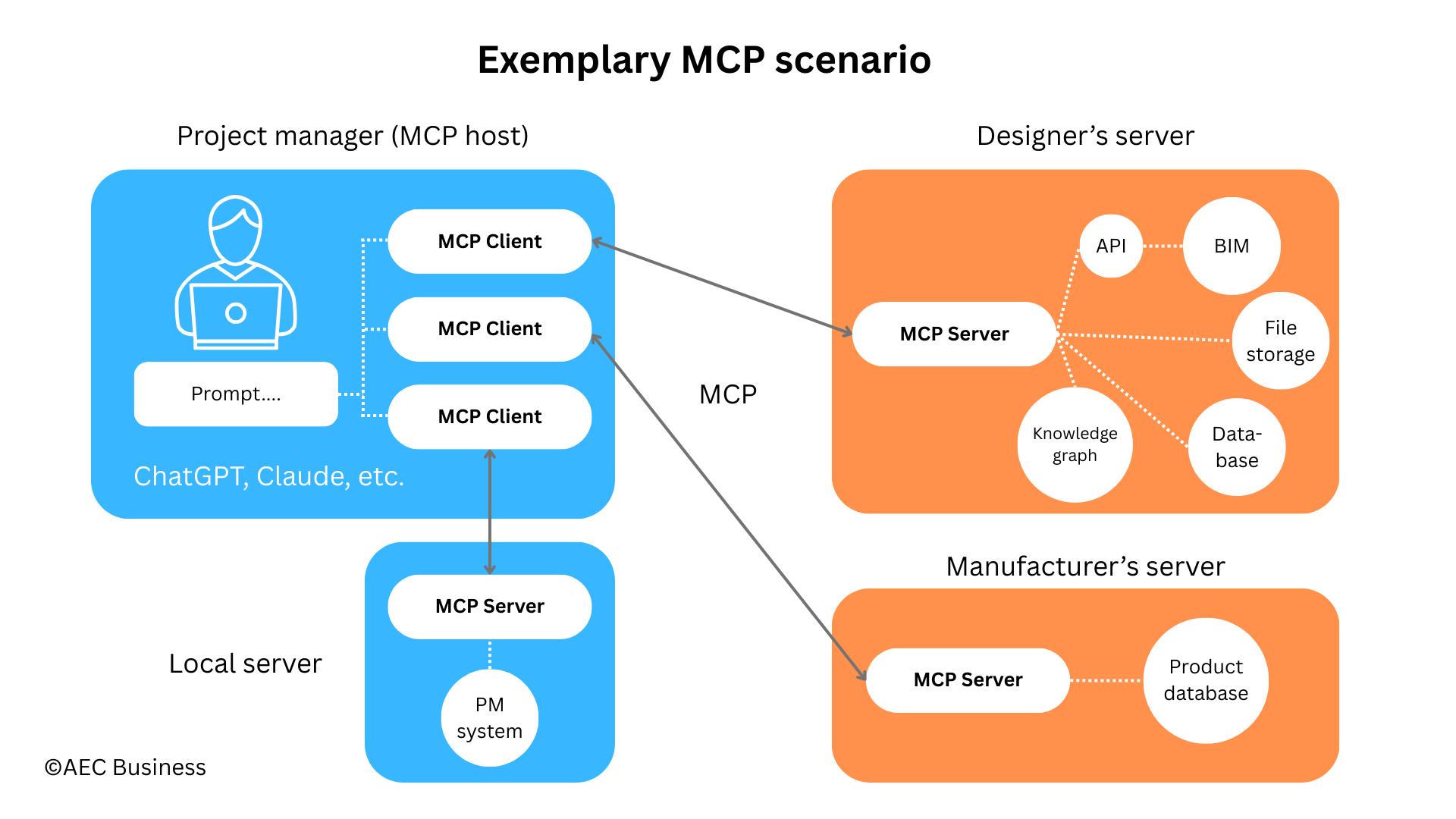The AEC sector’s longstanding problem is the lack of data flow among processes and project participants. We’ve tried to fix it with shared file repositories, shared BIM models, and APIs that enable software data exchange. Despite new AI tools, the issue remains. But there may be a solution.
Anthropic released MCP (Model Context Protocol) in November 2024 to enable AI systems to access diverse data sources in a standardized way. It has gained rapid acceptance among developers, and some AEC tech developers are already exploring it.
Could MCP be the missing link to make AEC data accessible and useful for everyone? After all, it has been called the “USB-C of AI apps.”
The concept
Currently, AI tools like ChatGPT primarily operate based on the information provided in the prompt and their own training data. If you want them to access live project data, BIM models, or internal company tools, you need custom integrations or proprietary APIs.

Traditional APIs are made for developers, not AI models. They require additional layers of interpretation before AI can utilize them effectively. MCP provides a standard “language” (message format) for AI models to request data or perform actions, and for data providers to respond.
With MCP, you can:
- Expose selected data (e.g., from a BIM database, cost estimating tool, or project schedule)
- Give the AI limited actions (e.g., run a query, validate a model, generate a report)
- Control what it can and can’t do
- Do all this without retraining the AI
MCP servers
To use MCP, an AI agent connects to an MCP server. It is software that acts as a bridge between the AI and one or more of the data provider’s systems (API, project management system, file storage, etc.) and knows how to communicate with them.
MCP servers can provide three main types of capabilities: resources (data for clients to read), tools (functions that the agent can call), and prompts (templates for workflows).
The MCP server offers machine-readable descriptions of its functions, including names, parameters, and explanations. This helps the AI agent understand what functions are available and how to use them.
The data provider chooses what functions the server exposes, for example, “getProjectStatus” or “fetchLatestIFCFile.” The AI can’t go beyond that.
MCP clients
Desktop AI assistants like ChatGPT and Claude act as hosts for MCP clients; they run built-in clients that connect to external or local MCP servers. The host spins a client instance for each server.
When you ask ChatGPT (the host) for project-specific data, it evaluates the available MCP servers and selects the right tool.
The MCP client then sends the server a structured request, the server executes the logic (for example, querying a BIM database), and returns structured results. ChatGPT interprets these results and weaves them into its natural-language response.


Possible AEC applications
You can envision many applications where MCP would become useful. Here are just a few examples:
- Construction process tracking: “Which components marked ‘fabricated’ in the BIM are still not installed on-site?”
- Knowledge reuse over projects: “What subcontractors have delivered similar MEP systems on time and on budget in the last five hospital projects?”
- Regulatory compliance: “Which materials specified in the BIM model have Environmental Product Declarations (EPDs)?”
- Product data retrieval: “Find alternative air handling units that meet the requirements of the designed unit.”
- Cross-disciplinary coordination: “Summarize all changes to the structural model since last week.”
- KPI monitoring: “How much embodied carbon is in the current design, and how does that compare to the original target?”
Making data actionable
To answer such questions, the agent must collect data from several systems. This only works if the data is standardized across sources, using consistent identifiers, units, and schemas.
The results can be combined either by the AI client or by the MCP server. Client-side joining provides flexibility, but server-side composition is generally faster, more consistent, and easier to manage.
I previously discussed knowledge graphs. A graph provides semantic meaning across systems, giving a connected, standardized view of the project. A graph, for example, connects the BIM element, the ERP component, and the functional purpose, and MCP provides the bridge between the AI agent and the graph.
Software support is emerging
Since MCP was only recently released, few AEC tools currently support it natively. However, there are multiple MCP server implementations for Autodesk Revit, developed by community contributors and AI-focused companies. The MCP servers communicate with Revit using the Revit API through WebSocket or HTTP connections.
Fragments is an open-source BIM format and toolkit designed to efficiently store, display, navigate, and edit large amounts of BIM data on any device. An early adopter, Helen Kwok, has developed an MCP server to convert IFC files into Fragments format, load Fragments, and query BIM data by category.
From a concept to business use
Although MCP remains in an exploratory phase within AEC, it is positioned to become an essential technology for integrating AI into workflows. Instead of humans prompting an LLM, AI agents can invoke MCP tools autonomously, which allows automation of workflows, for example, for supply chain management.
By monetizing your structured project data through AI-ready MCP servers, you can make revenue per query while creating a strong incentive to invest in higher data quality.
MCP is still evolving and requires improvements in security, governance, and certain technical capabilities. However, I recommend staying current and experimenting with MCP-enabled workflows today in secure environments.
View the original article and our Inspiration here


Leave a Reply